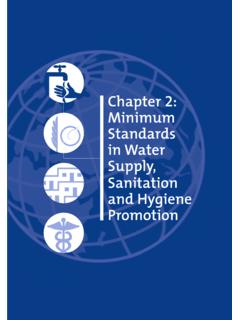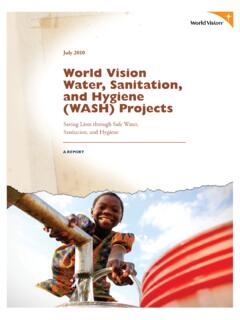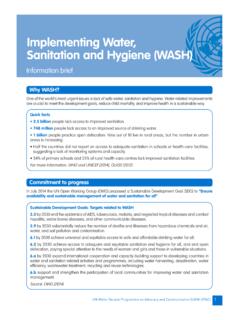Transcription of Hygiene Sanitation Handbook ENG - ec.europa.eu
1 Hygiene AND Sanitation Handbook 2018 1 TABLE of CONTENTS 1. GENERAL DEFINITIONS .. 3 CLEANLINESS .. 3 Hygiene .. 3 Sanitation .. 3 Hygiene AND Sanitation .. 3 THE IMPORTANCE OF Hygiene AND Sanitation IN FOOD SECTOR .. 4 2. FOOD SAFETY .. 5 CONTAMINATION .. 7 STERILIZATION .. 7 DISINFECTION .. 8 FOODBORNE DISEASES .. 8 ROPE DISEASE .. 10 MOLDINESS .. 11 FOOD POISONING SYMPTOMS .. 12 WHAT ARE SOURCES OF FOOD CONTAMINATION ? .. 13 3. Hygiene AND Sanitation PRACTICES IN FOOD OPERATING .. 13 Hygiene AND Sanitation BEFORE PRODUCTION .. 14 PRECAUTIONS TO BE TAKEN DURING THE PRODUCTION .. 16 PRECAUTIONS TO BE TAKEN AFTER THE 19 PEST CONTROL OF FOOD INDUSTRY .. 22 Insects .. 22 Rodents .. 23 Birds, Domestic Animals and Wild Animals .. 23 4. PERSONNEL Hygiene .. 24 R ULES FOR THE PERSONNEL .. 24 EMPLOYER RESPONSIBILITIES .. 26 5. OPERATING STRUCTURE AND DESIGN.
2 27 PROPERTIES .. 27 6. WATER Hygiene .. 32 IMPORTANT MICROORGANISMS TRANSMITTED BY WATER .. 32 CAUSES OF WATER CONTAMINATION .. 33 WATER CLEANING .. 33 Physical Methods .. 34 2 Chemical Methods .. 34 CHEMICALS USED FOR WATER DISINFECTION .. 34 Ozone .. 34 Iodine .. 34 Potassium Permanganate .. 35 Chlorinated Lime (limestone, javelin, calcium hypochlorite) .. 35 Correction of Water Chemical Deficiencies .. 35 7. GOOD MANUFACTURING PRACTICES .. 36 GOOD MANUFACTURING PRACTICES FOR FOOD SECTOR .. 36 8. FOOD SAFETY MANAGEMENT 37 HACCP (Hazard Analysis Critical Control Point) .. 38 STANDARD Sanitation OPERATION PROCEDURES (SSOP) .. 39 REFERENCES .. 40 3 1. GENERAL DEFINITIONS CLEANLINESS Cleanliness is to purify from the visible dirt in the production area by using water, air and various chemical materials in the bakery sector. Hygiene Hygiene is the process of cleaning an environment from all sickness factors which may cause health problem.
3 Hygiene process involves all the precautions to be taken in order to reduce microorganisms. Sanitation Sanitation is the creation of a clean and hygienic environment and making it sustainable. Hygiene AND Sanitation Hygiene and Sanitation process can't be divided each other in the bakery sector. Hygiene is the purification of the environment from microorganisms causing diseases, the other hand Sanitation is the measure taken for cleaning and Hygiene . Sanitation is the purification of foreign substances, microorganisms, drugs, cleaning agents and all visible sources of pollution from the production environment . 4 THE IMPORTANCE OF Hygiene AND Sanitation IN FOOD SECTOR All kinds of food must be purified from any; physical pollution such as glass, metal pieces, stone, sand, chemical pollution such as liquid fuels, detergents and residual of drug, biological pollution sources such as bacteria and mildew to good quality, healthy and safety.
4 Contaminated food can cause quality problem and the other hand healthy problem can be observed. Hygiene and Sanitation should be effectively applied and controlled at every step during manufacturing processes. If quality control process are not applied effectively during manufacturing, these problems which are listed below can be observed. Decreasing number of sales and consumption Exposure to legal proceedings Loss of prestige Production lag Lack of motivation in the company Food poisoning or nutritional diseases Claim for damage 5 2. FOOD SAFETY Food safety is protection to consumer from risk of food poisoning. Food safety covers all methods for destroying physical, chemical and biological of hazards. Food borne disease can cause a health problem for kids, pregnant and elderly consumers. Food borne disease may ends up with death. There are 3 sources of contamination in food sector: Physical, Chemical and Biological.
5 Examples of foreign substances, stalks, garbage, plastic, dust, soil, stone and metal contained in food are examples of physical contamination in foodstuffs. Chemical agents are not naturally found in the composition of food, but we can give examples such as substances, detergents, contaminants, disinfectants which are added during manufacturing. 6 Biological pollution sources are bacteria, fungi, viruses, mildew, mice and insects. All the pollution factors mentioned above are able to infect food at any step of food during manufacturing. For this reason, it is important to carry out effective control throughout the entire production process. Therefore, the supplier, the manufacturer, the ship unit, the sales unit and also the consumer are responsible for food safety. Food safety and quality is regulated by applying food safety and quality programs in the bakery sector.
6 7 CONTAMINATION Food contamination refers to the presence in food of harmful chemicals and microorganisms which can cause consumer illness. Contamination can occur directly with chemical, physical and biological agents, or indirectly through cross contamination. Cross contamination is the indirect transmission of harmful agents to foods. For example, if you use the same knife for cutting a bread and a watermelon, this situation can lead to cross contamination. STERILIZATION Sterilization refers to any process that eliminates, removes, kills, or deactivates all forms of life and other biological agents present in a specified region, such as a surface, a volume of fluid, medication, or in a compound such as biological culture media. The purpose of sterilization is effacing all microorganisms. 8 DISINFECTION Disinfection is the process of purifying foodstuffs and surfaces that are contacted with foodstuffs from microorganisms except spores that can cause disease by various methods.
7 It is made by chemical substances or heat. The chemicals used for disinfection are called "disinfectants". FOODBORNE DISEASES The accumulation of chemical substances, toxins, metals, agricultural and detergent residues in the body, parasites and harmful microorganisms cause food poisoning and foodborne diseases. Microorganisms, which are transmitted to foodstuffs from various sources, multiply rapidly under appropriate conditions. Microorganisms cause lacking qualities of foods and lead to foodborne diseases or poisoning. High amounts of toxic chemicals are harmful to human health. If chemical agents are passed over the limitation, food poisoning can be observed. Thinner, bleach, salt spirit and other chemical agents sometimes could be toxic. However, mostly reasons of food poisoning are drugs and foods. Poisonous mushrooms, contaminated water with agricultural or industrial chemicals and foods that are not properly prepared can cause poisoning.
8 Metal containers that are unsuitable for food storage and that give toxic substances into food can also cause food poisoning. Foods should not be stored in untinned copper, aluminum, unsuitable plastic container. 9 Agricultural medicines can also contaminate food because of unconscious and faulty applications. Medicines, insecticides and rat poisons used against agricultural harms are generally known as pesticides. The reasons of drug poisoning are listed in below; 1. Applying pesticide, without any protection method, 2. Leaving pesticide where people contact by accident especially kids and also if pesticide mix with water or food this situation may causes drug poisoning. Some food contain naturally elements compounds which are called toxine. Aflatoxin on the dried fruits, some types of poisonous mushrooms and sprouted potatoes can lead to food poisoning and other diseases because they contain natural toxic substances.
9 Bacteria, viruses and mildew are the main cause of many foodborne diseases. Inappropriate hygienic condition during manufacturing cause bacterial growth therefore 10 food poisoning can be observed. Such microorganisms may be originated from raw material, water, personnel and ventilation system, also they can be transmitted from the conditions after the food is produced. These microorganisms can cause epidemics such as Hepatitis A, typhoid. In addition, bacteria such as Staphylococcus aureus, E. coli, Listeria, Salmonella, and Shigella can cause food poisoning. In every gram of wheat berry or farina could have microorganism spores about a million. Most of microorganism spores die during baking bread. However, while some disease-causing bacterial spores, which are very durable, remain alive, often afterwards they contaminate to the bread. Red stain disease caused by a bacterium that is transmitted later on the bread, and chalk disease that causes white stains on the bread are the diseases seen in the bread.
10 In red spot disease, red stains appear on the bread, whereas in chalk disease, white stains occur. Both diseases can be prevented by providing the necessary hygienic conditions. The most common problem in the bakery sector is the disruption caused by Rope disease. ROPE DISEASE Rope is a bread disease caused by bacteria called Bacillus mesentericus and Bacillus subtilis. This bacterium makes resistant sports to high temperatures. The bacteria spores, which are activated after the dough has been made, remain intact when the temperature of the bread is not 100 degrees. These live spores multiply rapidly in the bread and begin to show bacterial effects. The enzymes that secreted by the bacteria decompose parts of the starch and protein in the bread. People smell musty from the inside of the bread on the first days. As the disease progresses, stickiness and odor increase in the bread.

















